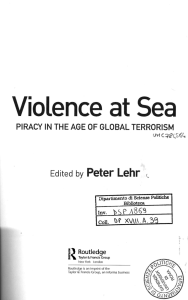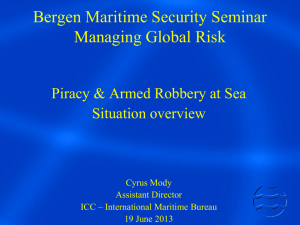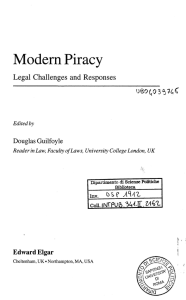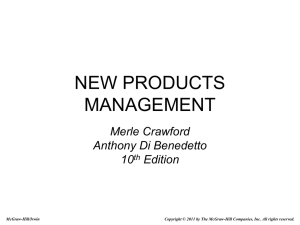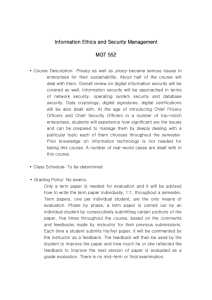United States' Unfair Competition Acts and
advertisement
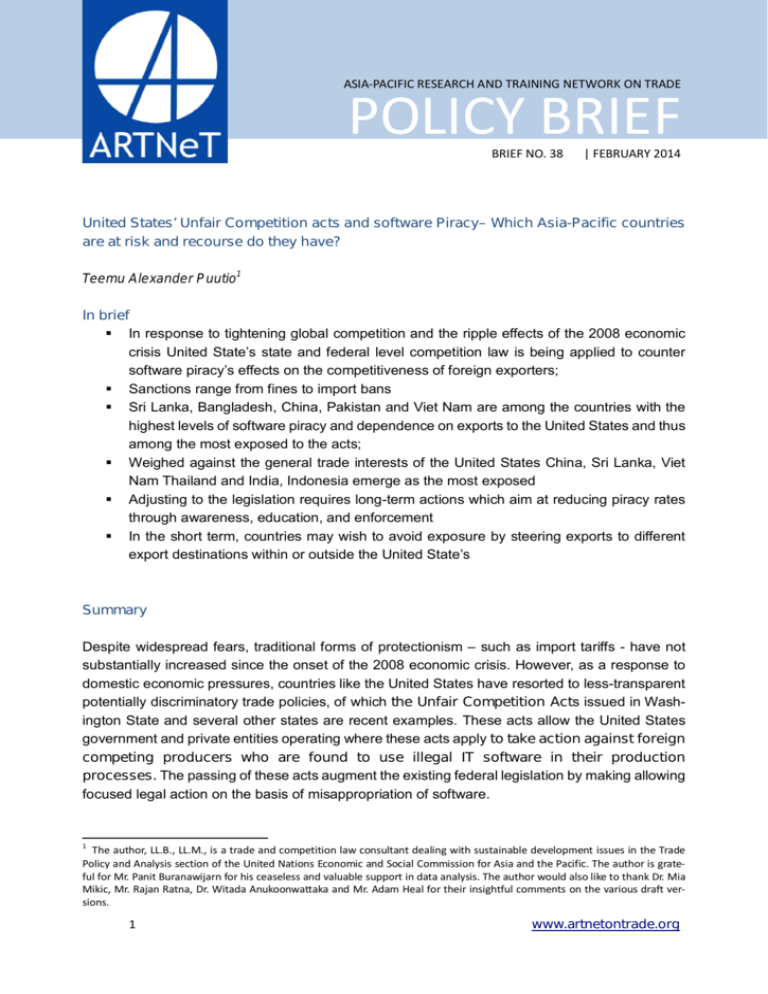
ARTNeT Policy Brief No. 38 ASIA-PACIFIC RESEARCH AND TRAINING NETWORK ON TRADE POLICY BRIEF BRIEF NO. 38 | FEBRUARY 2014 United States’ Unfair Competition acts and software Piracy– Which Asia-Pacific countries are at risk and recourse do they have? Teemu Alexander Puutio1 In brief § In response to tightening global competition and the ripple effects of the 2008 economic crisis United State’s state and federal level competition law is being applied to counter software piracy’s effects on the competitiveness of foreign exporters; § Sanctions range from fines to import bans § Sri Lanka, Bangladesh, China, Pakistan and Viet Nam are among the countries with the highest levels of software piracy and dependence on exports to the United States and thus among the most exposed to the acts; § Weighed against the general trade interests of the United States China, Sri Lanka, Viet Nam Thailand and India, Indonesia emerge as the most exposed § Adjusting to the legislation requires long-term actions which aim at reducing piracy rates through awareness, education, and enforcement § In the short term, countries may wish to avoid exposure by steering exports to different export destinations within or outside the United State’s Summary Despite widespread fears, traditional forms of protectionism – such as import tariffs - have not substantially increased since the onset of the 2008 economic crisis. However, as a response to domestic economic pressures, countries like the United States have resorted to less-transparent potentially discriminatory trade policies, of which the Unfair Competition Acts issued in Washington State and several other states are recent examples. These acts allow the United States government and private entities operating where these acts apply to take action against foreign competing producers who are found to use illegal IT software in their production processes. The passing of these acts augment the existing federal legislation by making allowing focused legal action on the basis of misappropriation of software. 1 The author, LL.B., LL.M., is a trade and competition law consultant dealing with sustainable development issues in the Trade Policy and Analysis section of the United Nations Economic and Social Commission for Asia and the Pacific. The author is grateful for Mr. Panit Buranawijarn for his ceaseless and valuable support in data analysis. The author would also like to thank Dr. Mia Mikic, Mr. Rajan Ratna, Dr. Witada Anukoonwattaka and Mr. Adam Heal for their insightful comments on the various draft versions. 1 www.artnetontrade.org ARTNeT Policy Brief No. 38 Non-compliance with these acts can lead to severe sanctions such as import bans, which may have devastating effects not only for the exporter but also for the laborers and other stakeholders involved. Countries can assess their potential exposure to the acts by using seemingly simple indicators such as piracy rates and the share of their exports of manufactured goods to the United States in the overall such exports. Using these metrics, it appears that exports from countries such as China, India, Indonesia, Thailand, Sri Lanka, and Viet Nam, are relatively exposed to adverse effects from the legislation. Countries with piracy rates below the regional average such as Japan and the Republic of Korea also face risks largely influenced by the fact that they export goods which to which the United States reacts more sensitively to including automotives, aviation, food and agriculture, and beverages. To counter these risks countries should: boost government led efforts towards ensuring compliance to national copyright laws; educate and raise awareness among stakeholders; identify the exposure of the country’s exporters to the acts and avoid unnecessary exposure wherever appropriate by e.g. instating policies which support diverting exports to other countries in the short-term. Finally, it is suggested that the United States considers the utilization of import taxes to correct the economic effects of the competitive advantage gained through the use of illegal IT in lieu of import bans. 2 www.artnetontrade.org ARTNeT Policy Brief No. 38 1. State level laws with international consequences Against valid fears, global protectionism has not substantially increased since the onset of the 2008 economic crisis (IMF 2012). However, as a response to growing protectionist pressures many countries have resorted to less transparent potentially discriminatory trade policies (ARTNeT, 2011). A recent manifestation of such policies is the Unfair Competition Act issued in Washington State, a trade-hub state of the United States in 2011, and several other acts in other states with similar objectives (henceforth “the acts”).2 These acts augment the Federal Trade Commission Act, which has for long enabled taking action on a plethora of competition policy issues including IT software piracy. As such, these acts can be seen as strengthening the focus of United States’ competition policy interventions on IT software piracy instead of establishing a new legal environment. What is more novel however, is the direct application of national competition law policies on foreign competitors. Typically state laws are applicable only to the entities operating within that state. Intellectual property rights legislation concerning illegal IT software is limited to national application as well. In the case of the acts, state-level competition law is harnessed for the purposes of international trade policy. As a consequence the scope of the acts are extended beyond state boundaries to international trading partners, making it extremely relevant to countries with significant manufacturing exports to the United States through Washington, California and more than a dozen other states which are currently in various stages of implementation of similar acts. The political undercurrents behind the application of the acts are significant. Thus far, the majority of the cases have been initiated and managed by state Attorney Generals, all of whom are elected state officials. It is safe to expect that the application of the acts will be influenced by state level lobby groups and agendas. The acts allow direct competitors operating within these states and the local government authorities to take legal action against entities selling or offering products produced with the help of illegal IT software. These entities need not be registered within the state or the elsewhere in the United States. The acts apply to all exporters whose products enter the state either in passing or as a final destination. Thus far, cases have been brought against Chinese clothing manufacturers, Thai seafood exporters and Brazilian aviation mechanics which were found to use illegal IT software in some part of their production processes. In certain cases, the acts allow action to be taken against third parties who sell products which incorporate outputs produced with the help of illegal IT software. Exempt from the purview of the acts are only regulated medical products, foods and beverages, copyrightable products or products which display copyrightable work, and products which involve alleged infringements of patents or trade secrets. 2 Wash. Rev. Code § 19.330 et seq. A similar law has been passed in Louisiana in 2010 while several other states including Arizona, California, Connecticut, Illinois, Indiana, Kentucky, Massachusetts, Missouri, New York, North Carolina, Oregon and Utah are currently in various stages of drafting comparable laws. At the same time, the U.S Federal Trade Commission (FTC) has been urged by several Attorney Generals to strengthen the enforcement of the Federal Trade Commission Act in protection against IT infringements by foreign exporters. While the paper uses the term “the acts” to refer the body of similar state and federal acts it should be noted that the laws in question may differ significantly. 3 www.artnetontrade.org ARTNeT Policy Brief No. 38 Without doubt, the acts serve legitimate purposes. Firstly, the acts inhibit illegal use of IT software in the United States and abroad, strengthening due remuneration for innovation and creativity potentially enabling long-term benefits from increased investment to software development and localization. Secondly, the acts address potential biases in both short-term and long-term trade and economic development outcomes which can emerge from the fact that the use of illegal software in manufacturing processes can give enormous competitive advantages. In the case of China, it is estimated that use of illegal software provide a competitive advantage at a tune of more than $837 million per year. This is a cost saving equivalent to hiring of 217,000 employees on average wage levels (Keystone 2012). Thirdly, the acts can be seen as strengthening the rule of law in all countries which criminalize software piracy by providing an additional layer of enforcement and source of deterrence in the United States. However, the acts also have several drawbacks which pose threats to countries exporting to the United States. From the viewpoint of individual exporters operating from Asia-Pacific countries, the transparency and accessibility of state level laws, in particular when several such laws co-exist alongside federal legislation, is murky at best. Without dedicated efforts to spread information about the acts and their potential consequences for exporters, compliance by exporting entities will remain low. The emergence of the ‘factory Asia’ model of production exacerbates the problem of ensuring compliance within a complex chain of interconnected producers all adding value towards a single product. This is due to the fact that the acts apply throughout the supply chain, leaving the final exporter liable for the infringements of upstream suppliers. The acts also enable questionable trade policy enforcement through selective, and even retaliatory, utilization of its provisions. The use of illegal IT software is highly uniform within the individuals and businesses within a particular country, depending largely on e.g. level of income, attitude towards piracy and effectiveness of law enforcement. In a country where piracy is rampant, whole industries relying on exports to the United States could be seriously affected with a small number of allegations against major exporters. Furthermore, the fact that cases can be initiated by harmed manufacturers leaves the possibility for foreign manufacturers to bring cases against other foreign manufacturers – establishing a new forum for trade retaliations.3 Such retaliation could take place particularly between competitors looking to grab larger pieces of the global value chains. 2. From fines to import bans – the price of piracy Most often, cases are initiated by the Attorney General through an exchange of letters. The attention of Attorney Generals’ is drawn to specific exporters not only through cues and allegations dropped by lobbyists or harmed competitors, but also through established cases of infringement abroad. In fact, the majority of cases thus far have relied on the pre-established knowledge that the targeted exporters, or their suppliers, had been found guilty of IT software piracy in their national court system. 3 The acts require that the plaintiff is directly competing with the manufacturer, be based on in the state and also sell its products within the state. 4 www.artnetontrade.org ARTNeT Policy Brief No. 38 Once a case is brought against an exporter in the United States, it has 90 days to remedy the alleged violation by e.g. acquiring the required licenses or to prove its compliance. During this period, the exporter can seek to settle the case similarly to the Thai seafood producer which accepted a fine of $10,000 and signed an agreement ensuring proper licensing of IT software in the future. Non-compliance can lead to fines, seizure of the products, injunctions against ongoing and future sales and damages which, in the case of willful violations can be awarded treble. The seizures and injunctions effectively constitute an import ban, imposed on a single entity. Depending on the reliance of the company on the US as an export destination, the consequences of such a ban can be substantial and ripple across the whole industry and all the stakeholders involved. Whether the sanctions are in line with the severity of the transgression can be validly questioned. Piracy undoubtedly harms the copyright owners and the industries which service them. However, it is not instantly obvious that the harm to an individual right’s holder justifies import bans which may end up causing more harm to a larger amount of stakeholders than the original transgression. It is only once the competition effects of using illegal IT software are accounted for that the use of import bans emerges as a more justifiable sanction. The unfair competitive advantage gained by utilizing illegal IT software can lead to severe long-term distortions in the competitive outcomes, to which redress cannot be given by fines alone. Even then it can be argued that an import ban is too strict of a sanction. Indeed, the unfair competitive advantage gained by utilizing illegal IT software - i.e. the lower cost of the products exported – could well be addressed by additional import taxes which would bring the price of the exports closer to what they would be if legal IT would have been used. 3. Assessing Asia-Pacific’s exposure to the Unfair Competition acts and import bans As a region, the Asia-Pacific has significant exposure to the acts and their potential negative consequences. The overall piracy rate of the region is 60 per cent with countries like Indonesia and Bangladesh reaching 90 and 86 per cent respectively (BSA 2012). In many of the Asia-Pacific countries, IT piracy is a silently accepted practice with law enforcement unable or unwilling to produce tangible effects. The acknowledged or accidental utilization of illegal IT software at some point of internal production processes is likely for many exporting companies. Given the high likelihood for such transgressions in individual companies within the region, the probability of illegal IT software being used at some point along the more complex supply chain is significant. Thus, even exporters hailing from countries like Japan, the Republic of Korea and Singapore – countries where pirate rates are estimated to be lower than the global average – are not exempt from the threat of import bans due to their key positions in the ‘Factory Asia’ production model. 5 www.artnetontrade.org ARTNeT Policy Brief No. 38 The mere piracy rates4 within a country are not a valid indicator for the exposure to the acts and the threat of its sanctions. Combining the piracy rates, which we take as a proxy of the likelihood of exporting companies engaging in piracy5, with the share of the United States as an export destination for the countries from which these companies operate from6, gives a more refined view of the exposure. The figure 1 summarizes the liability risk exposure of those Asia-Pacific countries for which there is sufficient data for determination of both indicators:7 Figure 1. Index of Exposure to United States' Unfair Competition acts 20 18 16 14 12 10 8 6 4 2 0 Source: Author’s own calculations based on UNCTAD trade data and BSA 2012 piracy study data. Figure 1 shows that in general, Sri Lanka, Bangladesh, China, Pakistan and Viet Nam are most significantly exposed to the Acts, because of their high piracy rates and strong relative dependence on the United States through manufacturing exports. However, these figures alone are not a meaningful indicator of the concrete likelihood of cases being brought against the country’s exporters. To inch closer towards such an indicator, we need to also examine what are the categories of products which the United States is mostly likely to initiate trade or IT piracy related disputes in. Figure 2 illustrates all trade disputes under the WTO dispute resolution system with the United States as the complainant, based on which some inferences can be made on the 4 The Business Software Alliance (BSA) indicator relies on survey data based on which a rate of use of pirated software is calculated. 5 The overall national piracy rate is taken as a representative estimation of the piracy rate of exporting companies due to the lack of better estimates. Exporting companies often differ from non-exporting companies in important ways, including stronger focus on accountability and auditing due. Thus the piracy rate might for exporting companies might in fact be lower than the overall piracy rate. 6 Ideally one would use data company level data to augment the level of detail. 7 The index is created by multiplying the estimated piracy level with the United State’s share of manufacturing exports. The index can give valuable insights to the overall exposure in relation to other countries. The theoretical maximum is 100 per cent piracy rates and 100 per cent of exports going to the United States which would give an index of 10 000. 6 www.artnetontrade.org ARTNeT Policy Brief No. 38 likelihood of certain sectors being targeted by the United States’ by trade disputes, including through the Acts. Figure 2 – Number of United States’ trade disputes in the WTO per broad categories Automotives Aviation products Beverages Copyrighted goods Food and agricultural products Garments Intellectual property rights related goods Services Other commodities including steel Patents Source: Author’s own estimation, based on WTO statistics on the dispute resolution system. Figure 2 illustrates that products falling under the broad categories of food and agricultural products, automotives, technology products, copyrighted goods have received the most attention from the United States in the WTO forum. When we combine the categories which have gathered the most attention in WTO with the top export categories of the United States8 we can formulate a list of “sensitive” product categories. It is safe to assume that to some extent the likelihood of utilization of the Acts is higher when the exports fall under these sensitive categories. The following matrix (Table 1) shows whether the countries mentioned in figure 1 have significant amounts of exports to the United States under these sensitive categories.9 The overall exposure index for each country is then multiplied by the amount of sensitive categories the country has significant exports to the United States in. This table gives us a more refined picture of the weighted exposure to the acts. 8 Here we assume that the industries with the best export performance are the ones with the strongest lobbies and thus the most likely to utilize the act in reaction to foreign competition. 9 Each sensitive category is marked with an ’x’ if more than 5 per cent of the country’s exports to the United States fall under that category. 7 www.artnetontrade.org ARTNeT Policy Brief No. 38 Table 1. Weighted exposure of selected Asia-Pacific countries to the Unfair Competition acts10 Automotives China Aviation Food and Agriculture X Machinery X Technology products X Rubber and Plastics Pharmaceuticals X X Sectors with more than 5% of total exports to US 5 General exposure index Weighted exposure 12.82096 64.1048 X Sri Lanka X X 3 17.75683 53.27049 X Viet Nam X X 3 11.77866 35.33598 X Thailand X X X X 5 5.489121 27.44561 X India X X X X 5 5.150694 25.75347 X Indonesia X X X X X X X X X Turkey 16.70281 4.143441 16.57376 X X X X 4 3.967191 15.86876 X 1 12.24426 12.24426 X X X 3 3.505861 10.51758 X X X X Armenia X 5 1.895937 X X 3 1.720915 5.162745 X New Zealand Australia X 9.479685 Singapore X 2 0.712398 1.424796 X X X 3 0.386604 1.159812 X 1 0.382225 0.382225 Based on UNCTAD 2013, BSA 2012, and Harvard 2013. 8 1 4 Pakistan Japan 4.63157 16.70281 Malaysia Republic of Korea 5 23.15785 Bangladesh 10 Garments www.artnetontrade.org ARTNeT Policy Brief No. 38 Based on the weighted exposure index, China, Sri Lanka and Viet Nam seem particularly exposed to the acts. India, Indonesia and Thailand are also at high risk. These results largely correlate with the fact that all of these countries have faced trade disputes both under the acts and within the WTO dispute resolution system as initiated by the United States. Countries with piracy rates below the regional average such as Japan and the Republic of Korea also face risks largely influenced by the fact that their exports fall under categories which are more sensitive to the United States. The matrix shows that not all countries with ostensibly high levels of exposure to the acts are likely to come under United States scrutiny under the acts. In the case of Georgia for example, the exports of which consist mainly of ferroalloys and oil products, litigation under the acts is unlikely as none of its exports fall under the identified sensitive categories. In the case of countries such as Malaysia, which have smaller exposure indicated by the crude metric, but which have diversified exports along food and agriculture, technology and garment products are under a higher de facto risk. The matrix does not assess the state-level exposure, due to its complex nature. To do so would require examining the composition of the production within the state, the presence and strength of lobbyist groups and also the high-level trade policy agendas of the state. Many of the products under these categories enjoy of the block exemption under the acts. However, it must be noted that the exemptions are applicable only in the state of Washington, and thus manufacturers of e.g. food products can be prosecuted in other states, as was the case with the Thai seafood manufacturer prosecuted in Massachusetts. 4. Ways to address heightened exposure - comply, educate, identify and avoid The suggested course of action for countries finding themselves at risk of heightened exposure is three-fold. The first-best option for all countries which have national legislation which define IT piracy as either a civil or criminal offence is to ensure compliance with the existing laws. Governments should lead the way towards compliance by utilizing appropriately licensed software. Those governments facing budgetary constraints may wish to seek open-source alternatives whenever appropriate. Enhanced compliance within the manufacturers can be achieved by systematic enforcement, including auditing of most likely infringers and largest exporters. Strengthening compliance will not only limit the country’s exposure, but it will also provide marginal increases to the GDP growth through increased spending on IT software (Ernst&Young 2012). At the same time, manufacturing overheads are likely to increase, potentially affecting the export prices. However, these effects are likely to be fairly insignificant (Ernst&Young 2012). In addition to ensuring compliance directly, governments are suggested undertake educational and awareness building interventions. Studies have shown that the wil9 www.artnetontrade.org ARTNeT Policy Brief No. 38 lingness of Asia-Pacific manufactures purchase legal IT software is increasing all the while as awareness of the availability of legal software and the consequences of using illegal software remain low (Ernst&Young 2012). Funding targeted awareness raising campaigns, and facilitating access to legal software through e.g. online-marketplaces are viable measures for boosting the compliance of manufacturers. Efficiently controlling the exposure requires that it is first correctly identified and assessed. To this end, governments are encouraged to utilize the methodology detailed above with their own estimates of piracy rates of exporters and the most accurate export data. Based on the findings of this report and their own assessments, Governments may wish to consider supporting the exporting companies in avoiding exposure through other means. Where compliance seems unlikely in the short-term, diverting exports to other destinations might be a valid course of action. For countries which face problems in ensuring compliance within supply chains, exposure can be avoided by requiring all supply chain nodes to sign non-infringement agreements which contain concrete enforcement provisions such as those enabling periodical audits. Finally, it is suggested that the United States takes into due consideration to potentially far reaching negative effects of import bans. As such, the United States may wish to consider the utilization of import taxes to correct the economic effects of the competitive advantage gained through the use of illegal IT. In addition, the United States may wish to consider utilizing other, more established and transparent, forums and means to protect its interests related to copyrights. Such forums include the WTO dispute settlement mechanism which would allow litigation based on the provisions of the TRIPS agreement and others. 10 www.artnetontrade.org ARTNeT Policy Brief No. 38 Reference list ARTNeT (2011). Features of post--crisis protectionism in Asia and the Pacific. Available at http://www.unescap.org/tid/artnet/pub/wp9711.pdf Ernst & Young (2012). New Rules and Regulations on IT and fair competition – trends and impact. Available at http://www.ey.com/Publication/vwLUAssets/IT_trends_and_impact_en/$FILE/New-rul es-regulations-on-IT-and-fair-competition.pdf IMF (2012). Trade Policy: So Far So Good? http://www.imf.org/external/pubs/ft/fandd/2012/06/pdf/hoekman.pdf Harvard (2013). Atlas of Economic Complexity. Available at http://atlas.media.mit.ed Keystone (2012). Play Fair Day Analysis. Available at http://www.microsoft.com/en-us/news/presskits/antipiracy/docs/playfair_analysis.pptx UNCTAD, 2013. UNCTAD Trade Statistics. Available at http://unctadstat.unctad.org/ReportFolders/reportFolders.aspx 11 www.artnetontrade.org ARTNeT Policy Brief No. 38 The Asia-Pacific Research and Training Network on Trade ARTNeT – is an open network of research and academic institutions and think-tanks in the Asia-Pacific region, supported by core partners IDRC, ESCAP, UNCTAD, UNDP and WTO. ARTNeT aims to increase the amount of high quality, topical and applied research in the region by harnessing existent research capacity and developing new capacities. ARTNeT also focuses on communicating these research outputs to and for policymaking in the region including through ARTNeT Policy Briefs which provide updates on major issues distilled into an easy to read format. The views expressed in this publication are those of the author and do not necessarily reflect the views of the United Nations and ARTNeT secretariats or ARTNeT members. Readers are encouraged to quote or reproduce material from ARTNeT Policy Briefs for their own publications, but as the copyright holder, ARTNeT requests due acknowledgement and a copy of the publication. This and other ARTNeT publications are available fromwww.artnetontrade.org. ARTNeT Secretariat, United Nations ESCAP, Rajadamnern Nok Avenue, Bangkok 10200, Thailand. Tel: +66(0)22881410, Fax: +66(0)22881027, Email: artnetontrade@un.org. 12 www.artnetontrade.org

